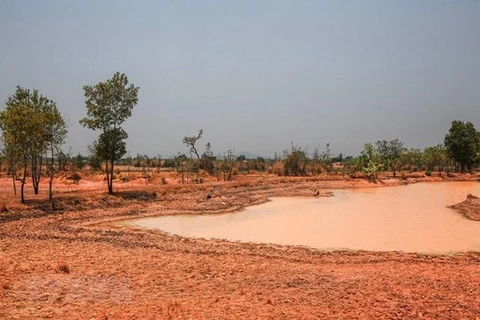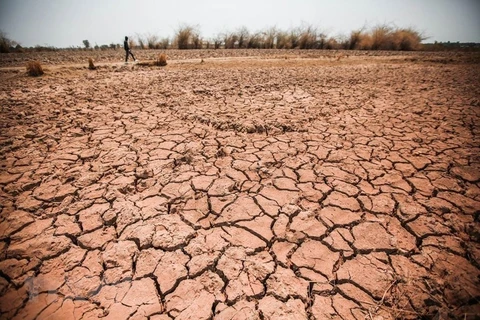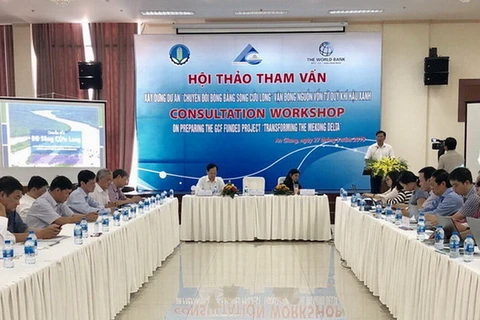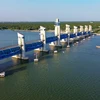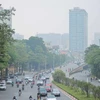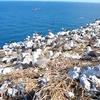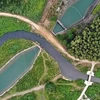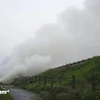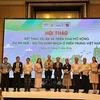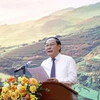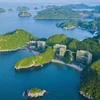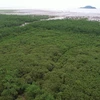Lam Dong (VNS/VNA) - Construction of small ponds to store water for irrigation under an official programme has helped farmers in Lam Dong province to cope with the current drought.
The project, implemented across the Central Highlands province in 2016-2020, requires the ponds, which draw groundwater and are also supplied by reservoirs, to be a minimum of 500sq.m and have a capacity of at least 1,500cu.m.
Farmers digging them are provided with a 50 – 70 percent subsidy of the cost of hiring digging machines.
There were 1,727 ponds, dug at a cost of 41 billion VND (1.76 million USD), as of the end of last year, with the province providing 22 billion VND (947,000 USD), according to the province Irrigation Sub-department.
In Cat Tien, Da Huoai and DA Teh districts, which did not get any rain last month and are suffering from a drought, farmers have dug 149 small ponds to serve 677ha of farmlands.
In Cat Tien, farmers in My Lam commune are harvesting their late maturing winter-spring rice and getting high yields thanks to the ponds.
Duong Thi Kim Tuyen said when her rice was close to ripening the commune was hit by drought and there was no water in the springs and rivers to irrigate her field, and she used water from one of the ponds instead. Tuyen got a yield of 10 tonnes per hectare, she said.
Pham Van Chuong, chairman of the My Lam Commune People’s Committee, said under the programme the commune has supported farmers with digging ponds, and they have proved very useful. The commune now has another 50ha of rice to be harvested, he said.
Cat Tien, the province’s largest rice producer, grows three crops a year on a total of 9,000ha. To supply water in the dry season, the district has built four pumping stations that can supply 100 – 300ha each.
But they are in poor condition and only one can still operate at full capacity. So farmers in drought-prone areas rely on the small ponds.
Nguyen Van Hue, deputy head of the irrigation sub-department, said the project has proved effective. Up to three households can together dig a pond on their land to take water for agriculture, he said.
Each pond can irrigate 5 – 7ha and the cost of digging one is only 20–25 million VND (860–1,000 USD), he added.
The province plans to dig 786 of them this year and have nearly 5,600 with a total area of 560ha by the end of next year.-VNS/VNA
The project, implemented across the Central Highlands province in 2016-2020, requires the ponds, which draw groundwater and are also supplied by reservoirs, to be a minimum of 500sq.m and have a capacity of at least 1,500cu.m.
Farmers digging them are provided with a 50 – 70 percent subsidy of the cost of hiring digging machines.
There were 1,727 ponds, dug at a cost of 41 billion VND (1.76 million USD), as of the end of last year, with the province providing 22 billion VND (947,000 USD), according to the province Irrigation Sub-department.
In Cat Tien, Da Huoai and DA Teh districts, which did not get any rain last month and are suffering from a drought, farmers have dug 149 small ponds to serve 677ha of farmlands.
In Cat Tien, farmers in My Lam commune are harvesting their late maturing winter-spring rice and getting high yields thanks to the ponds.
Duong Thi Kim Tuyen said when her rice was close to ripening the commune was hit by drought and there was no water in the springs and rivers to irrigate her field, and she used water from one of the ponds instead. Tuyen got a yield of 10 tonnes per hectare, she said.
Pham Van Chuong, chairman of the My Lam Commune People’s Committee, said under the programme the commune has supported farmers with digging ponds, and they have proved very useful. The commune now has another 50ha of rice to be harvested, he said.
Cat Tien, the province’s largest rice producer, grows three crops a year on a total of 9,000ha. To supply water in the dry season, the district has built four pumping stations that can supply 100 – 300ha each.
But they are in poor condition and only one can still operate at full capacity. So farmers in drought-prone areas rely on the small ponds.
Nguyen Van Hue, deputy head of the irrigation sub-department, said the project has proved effective. Up to three households can together dig a pond on their land to take water for agriculture, he said.
Each pond can irrigate 5 – 7ha and the cost of digging one is only 20–25 million VND (860–1,000 USD), he added.
The province plans to dig 786 of them this year and have nearly 5,600 with a total area of 560ha by the end of next year.-VNS/VNA
VNA


